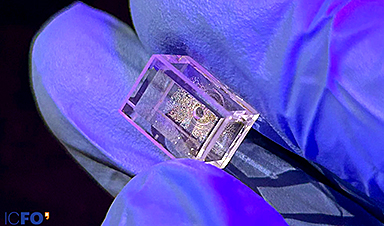New atomic sensor technology enhances MRI quality control by tracking hyperpolarized molecules in real-time, with potential benefits for various scientific fields.
Magnetic resonance imaging (MRI) is a fundamental tool in modern medicine, offering detailed views of internal organs and tissues. These large, tube-shaped MRI machines, commonly seen in hospitals, utilize powerful magnets to analyze and visualize the density of water and fat molecules within the body.
In addition to these molecules, other substances like metabolites can also be mapped, but their concentrations are often too low to produce clear images. To overcome this limitation, a technique known as hyperpolarization is employed to enhance the magnetic resonance signal of these substances, making them more visible during MRI scans.
Hyperpolarization involves preparing a substance outside the body in a state where its magnetization—key to creating MRI images—is near its maximum. This process can boost the signal by thousands of times compared to its natural state. Once hyperpolarized, the substance is injected into the patient and transported to the target organ or tissue. However, before this can happen, it is crucial to confirm that the substance is adequately hyperpolarized through rigorous quality control processes.
Current quality control techniques face two significant challenges. First, these methods often reduce the magnetization of the sample during the read-out process, thereby diminishing its ability to enhance the MRI scan. Second, the time required for measurement can be lengthy, during which the substance's magnetization naturally decays, limiting the opportunity for consecutive measurements. This results in a lack of critical data that could otherwise help maximize the efficiency of hyperpolarization. Furthermore, once the sample is hyperpolarized, there is a risk that it could lose its magnetization during transport to the MRI machine. Traditional quality control techniques, due to their time-consuming nature, may fail to detect this loss in time.

Now, a collaboration of IBEC researchers Dr. James Eills (now at Forschungszentrum Jülich, Germany) and Dr. Irene Marco Rius and ICFO researchers ICREA Prof. Morgan W. Mitchell and Dr. Michael C. D. Tayler has demonstrated how atomic sensor techniques overcome the limitations of conventional sampling when measuring the magnetization of hyperpolarized materials. This breakthrough was recently reported in the journal PNAS.
In particular, the team used optically pumped atomic magnetometers (OPMs), whose operating principles differ fundamentally from traditional sensors, enabling real-time detection of the fields produced by hyperpolarized molecules. The nature of OPMs allowed these researchers to perform continuous, high-resolution, and non-destructive observations throughout the entire experiment, including the hyperpolarization process itself.
According to the authors, if the field of hyperpolarization sensing was cinema, previous methods would be like a sequence of still photos, leaving the plot between frozen pictures open to the viewer's guess. "Instead, our technique is more like a video, where you see the whole story frame by frame. Essentially, you can observe continuously and without resolution limits, and this way you do not miss any details!" explains Dr. Michael Tayler, ICFO researcher and co-author of the article.
Unveiled behaviors of chemical compounds during magnetization
The team tested their OPMs by monitoring hyperpolarization in clinically relevant molecules. The atomic sensors' unprecedented resolution and real-time tracking allowed them to witness how the polarization in a metabolite compound ([1-13C]-fumarate) evolved under the presence of a magnetic field.
The atomic sensors revealed 'hidden spin dynamics' that had gone unnoticed until now, offering a new path towards optimizing the hyperpolarization from the very start of the process. "Previous methods obscured subtle oscillations in the magnetization profile, which previously went undetected," remarks Tayler. "Without the OPM, we would have achieved a suboptimal final polarization without even realizing." Beyond simple observation, the method could be used to control the polarization process in real-time and stop it at the most convenient point, for instance when the maximum polarization is attained.
The study revealed other unexpected behavior when the team applied a magnetic field to repeatedly magnetize and demagnetize the hyperpolarized fumarate molecule. They expected to see the magnetization increasing to a maximum and then going back to zero over and over, transitioning smoothly from one state to the other every time. Contrary to these simple expectations, the molecule exhibited complex dynamics due to hidden resonances at certain magnetization-demagnetization durations and magnetic fields.
"This understanding will help us detect when unwanted behavior occurs and adjust parameters (like the duration of the cycle or the intensity of the magnetic field) to prevent it," explains Tayler.
The work represents an advancement in hyperpolarized MRI technology, thanks in large part to the collaborative efforts of IBEC's Molecular Imaging for Precision Medicine group and ICFO's Atomic Quantum Optics group. IBEC expertise in hyperpolarization methods and ICFO's expertise in OPM sensing technologies were critical in achieving the results.
"This is a beautiful example of the new science that can be achieved when researchers from different disciplines work together, and the proximity of IBEC and ICFO meant we were able to collaborate closely and achieve something truly novel," acknowledges Dr. James Eills, IBEC researcher and first author of the article.
Dr. Tayler reflects on the team's success: "The OPM measurements worked beautifully from the start. The sensors' exquisite sensitivity revealed hidden dynamics we hadn't anticipated as if they were meant for this purpose. The ease of use and the wealth of new information make them a powerful tool for hyperpolarization monitoring."
Benefits for MRI and other future applications
The immediate application of this study would be to integrate portable atomic sensors into clinical sample quality control for MRI, something that is currently being implemented by the ICFO team in the Spanish Ministry Project "SEE-13-MRI". This way, one could guide molecules to the highest possible level of polarization during hyperpolarization and reliably certify the polarization level before substances are injected into patients.
The development could significantly reduce the cost and logistical challenges of metabolic MRI. If so, this would expand its reach from the handful of specialized research centers where it is currently used, to many hospitals worldwide.
However, the potential of atomic sensors extends far beyond medical imaging. The same non-destructive, real-time tracking system using optically-pumped magnetometers (OPMs) could be applied to monitor macromolecules in chemical processes, study high-energy physics targets, or even optimize spin-based algorithms in quantum computing. According to Dr. Tayler: "The method we've developed opens up new avenues not only for improving MRI but for various fields that rely on precise magnetic sensing, and we are excited about its further development."
Reference: "Live magnetic observation of parahydrogen hyperpolarization dynamics" by James Eills, Morgan W. Mitchell, Irene Marco Rius and Michael C. D. Tayler, 15 October 2024, Proceedings of the National Academy of Sciences.
DOI: 10.1073/pnas.2410209121
News
Scientists Melt Cancer’s Hidden “Power Hubs” and Stop Tumor Growth
Researchers discovered that in a rare kidney cancer, RNA builds droplet-like hubs that act as growth control centers inside tumor cells. By engineering a molecular switch to dissolve these hubs, they were able to halt cancer [...]
Platelet-inspired nanoparticles could improve treatment of inflammatory diseases
Scientists have developed platelet-inspired nanoparticles that deliver anti-inflammatory drugs directly to brain-computer interface implants, doubling their effectiveness. Scientists have found a way to improve the performance of brain-computer interface (BCI) electrodes by delivering anti-inflammatory drugs directly [...]
After 150 years, a new chapter in cancer therapy is finally beginning
For decades, researchers have been looking for ways to destroy cancer cells in a targeted manner without further weakening the body. But for many patients whose immune system is severely impaired by chemotherapy or radiation, [...]
Older chemical libraries show promise for fighting resistant strains of COVID-19 virus
SARS‑CoV‑2, the virus that causes COVID-19, continues to mutate, with some newer strains becoming less responsive to current antiviral treatments like Paxlovid. Now, University of California San Diego scientists and an international team of [...]
Lower doses of immunotherapy for skin cancer give better results, study suggests
According to a new study, lower doses of approved immunotherapy for malignant melanoma can give better results against tumors, while reducing side effects. This is reported by researchers at Karolinska Institutet in the Journal of the National [...]
Researchers highlight five pathways through which microplastics can harm the brain
Microplastics could be fueling neurodegenerative diseases like Alzheimer's and Parkinson's, with a new study highlighting five ways microplastics can trigger inflammation and damage in the brain. More than 57 million people live with dementia, [...]
Tiny Metal Nanodots Obliterate Cancer Cells While Largely Sparing Healthy Tissue
Scientists have developed tiny metal-oxide particles that push cancer cells past their stress limits while sparing healthy tissue. An international team led by RMIT University has developed tiny particles called nanodots, crafted from a metallic compound, [...]
Gold Nanoclusters Could Supercharge Quantum Computers
Researchers found that gold “super atoms” can behave like the atoms in top-tier quantum systems—only far easier to scale. These tiny clusters can be customized at the molecular level, offering a powerful, tunable foundation [...]
A single shot of HPV vaccine may be enough to fight cervical cancer, study finds
WASHINGTON -- A single HPV vaccination appears just as effective as two doses at preventing the viral infection that causes cervical cancer, researchers reported Wednesday. HPV, or human papillomavirus, is very common and spread [...]
New technique overcomes technological barrier in 3D brain imaging
Scientists at the Swiss Light Source SLS have succeeded in mapping a piece of brain tissue in 3D at unprecedented resolution using X-rays, non-destructively. The breakthrough overcomes a long-standing technological barrier that had limited [...]
Scientists Uncover Hidden Blood Pattern in Long COVID
Researchers found persistent microclot and NET structures in Long COVID blood that may explain long-lasting symptoms. Researchers examining Long COVID have identified a structural connection between circulating microclots and neutrophil extracellular traps (NETs). The [...]
This Cellular Trick Helps Cancer Spread, but Could Also Stop It
Groups of normal cbiells can sense far into their surroundings, helping explain cancer cell migration. Understanding this ability could lead to new ways to limit tumor spread. The tale of the princess and the [...]
New mRNA therapy targets drug-resistant pneumonia
Bacteria that multiply on surfaces are a major headache in health care when they gain a foothold on, for example, implants or in catheters. Researchers at Chalmers University of Technology in Sweden have found [...]
Current Heart Health Guidelines Are Failing To Catch a Deadly Genetic Killer
New research reveals that standard screening misses most people with a common inherited cholesterol disorder. A Mayo Clinic study reports that current genetic screening guidelines overlook most people who have familial hypercholesterolemia, an inherited disorder that [...]
Scientists Identify the Evolutionary “Purpose” of Consciousness
Summary: Researchers at Ruhr University Bochum explore why consciousness evolved and why different species developed it in distinct ways. By comparing humans with birds, they show that complex awareness may arise through different neural architectures yet [...]
Novel mRNA therapy curbs antibiotic-resistant infections in preclinical lung models
Researchers at the Icahn School of Medicine at Mount Sinai and collaborators have reported early success with a novel mRNA-based therapy designed to combat antibiotic-resistant bacteria. The findings, published in Nature Biotechnology, show that in [...]





















